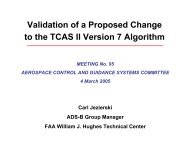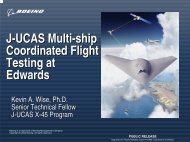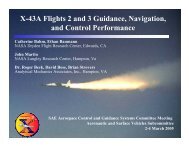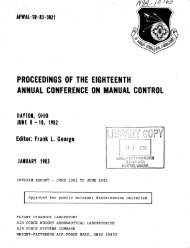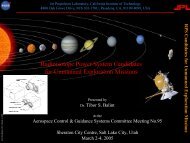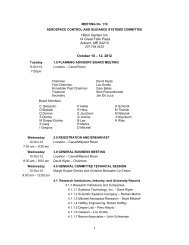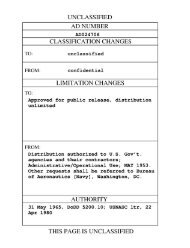Report of the Second Piloted Aircraft Flight Control System - Acgsc.org
Report of the Second Piloted Aircraft Flight Control System - Acgsc.org
Report of the Second Piloted Aircraft Flight Control System - Acgsc.org
Create successful ePaper yourself
Turn your PDF publications into a flip-book with our unique Google optimized e-Paper software.
Returning to <strong>the</strong> discussion <strong>of</strong> <strong>the</strong> azimuth control where <strong>the</strong> tip<br />
path plane is tilted by means <strong>of</strong> <strong>the</strong> tilt <strong>of</strong> <strong>the</strong> swash plate, we can<br />
appreciate <strong>the</strong> problems resulting from <strong>the</strong> f ollotdng considerations.<br />
The friction resulting from <strong>the</strong> fea<strong>the</strong>ring bearings, which are required<br />
to support a centrifugal force <strong>of</strong> approhately 5,000 lbs. is appreciable.<br />
The need for a fine balance is necessary between <strong>the</strong> aerodynamic thrust<br />
on each blade and <strong>the</strong> centrifugal force component projected along <strong>the</strong> line .<br />
<strong>of</strong> thrust which prevents <strong>the</strong> rotor from llconinglt too much. Also, <strong>the</strong><br />
variety <strong>of</strong> vibratory and gust disturbances transmitted into <strong>the</strong> control<br />
system from <strong>the</strong> aerodynamic surfaces which support <strong>the</strong> fulJ. weight <strong>of</strong> <strong>the</strong><br />
helicopter and which move as a complicated piece <strong>of</strong> machinery miqfit be<br />
d<br />
disconcerting. On top <strong>of</strong> this a helicopter is inherently unstable in<br />
hovering having an unstable mode with a period <strong>of</strong> <strong>the</strong> order <strong>of</strong> magnitude<br />
<strong>of</strong> 10 seconds or more. mile <strong>the</strong> pilot can cope with this unstable oscillation<br />
because <strong>of</strong> <strong>the</strong> long period, it is desirable that he make frequent<br />
corrections without undue effort. The problem was not insurmountable on<br />
helicopters <strong>of</strong> <strong>the</strong> 5,000 lbs. pose weight category, but did limit <strong>the</strong> size<br />
<strong>of</strong> <strong>the</strong> helicopter unless suitable potjer controls were developed. Various<br />
aerodynamic and gyroscopic devices have been incorporated on hellcopters. .<br />
Three <strong>of</strong> particular interest are <strong>the</strong> Bell stabiliqer bar, <strong>the</strong> Hiller control<br />
rotor and <strong>the</strong> Kaman blade tab. The Bell stabilizing bar is a large rate<br />
gyro rotating at rotor speed (its undamped natural frequency ie hence one<br />
times rotor speed) with viscous damping, which can be adjusted to optMze<br />
<strong>the</strong> stabilization obtainable with a raze gyro alone. The Hiller control<br />
rotor is a similar device which uses <strong>the</strong> blades <strong>of</strong> <strong>the</strong> control rotor to<br />
obtain aerodynamic damping. Ano<strong>the</strong>r feature <strong>of</strong> this control rotor is that<br />
<strong>the</strong> fea<strong>the</strong>ring produces flapping on <strong>the</strong> small control rotor which introduces<br />
fea<strong>the</strong>ring on <strong>the</strong> large rotor. In short, <strong>the</strong>re is an extra stage <strong>of</strong> an<br />
aerodpadc .servo in <strong>the</strong> control loop. The Kainan rotor, <strong>the</strong> tab is located<br />
on <strong>the</strong> blade near <strong>the</strong> tip. A preloaded cable control regulates <strong>the</strong> angle <strong>of</strong><br />
<strong>the</strong> tab which introduces a twisting moment on <strong>the</strong> blade, which in turn twists<br />
<strong>the</strong> very flexible blade to <strong>the</strong> desired angle without <strong>the</strong> use <strong>of</strong> fea<strong>the</strong>flng<br />
bearings. *Each <strong>of</strong> <strong>the</strong>se devices solve <strong>the</strong> problem in part, but have certain<br />
disadvantages as well. Power requirements for aerodynamic actuated torques<br />
should be considered, and tests run at Sikorsky <strong>Aircraft</strong> with tab controlled<br />
rotors wlth fea<strong>the</strong>rlne bearings indicated that <strong>the</strong> additional drag, due to<br />
this type <strong>of</strong> aerodynamic servo, resulted in power loss fran 5 to 1% <strong>of</strong> total<br />
power absorbed by <strong>the</strong> rotor.<br />
The use <strong>of</strong> hydraulic power appeared to be <strong>the</strong> most economical method <strong>of</strong> *<br />
improving <strong>the</strong> control <strong>of</strong> <strong>the</strong> helicopter. In 1949 a hydraulic pmr control<br />
for <strong>the</strong> three inputs <strong>of</strong> <strong>the</strong> swash plate was installed on <strong>the</strong> S-51 model<br />
helicopter (gross wei@t 5500 lbs.) The power control had infinite booet<br />
Q<br />
ratio, that is no feedback from <strong>the</strong> output to <strong>the</strong> input, operated at a<br />
pressure <strong>of</strong> 800 to 1,000 psi obtained from a constant displacement pump<br />
and unloading valve charging an accumulator. The awragle power requirement<br />
for this system was practically nil, being less than a quarter horeepaser.<br />
Although <strong>the</strong> original purpoeb <strong>of</strong> <strong>the</strong> control was to prove that <strong>the</strong> hellcopter<br />
could be flown with this type <strong>of</strong> control in order to pave <strong>the</strong> way for <strong>the</strong>



